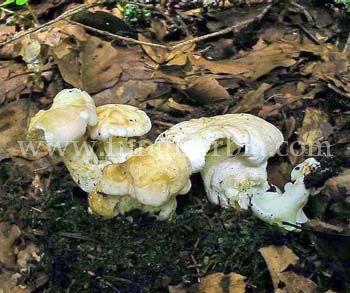Albatrellus ovinus (Schaeff.) Kotl. & Pouzar

Fruit body: cap up to 10 cm, fleshy, irregular, surface is often cracked, whitish to yellow-olive. Hymenium is made of tubes up to 3 mm long. Pores are decurent, very small, 3 to 5 on 1 mm, poroid surface is whitish, if damaged darkens to yellow-brown shades. Stem is up to 4x2 cm, eccentric, narrowing towards base, whitish to pale yellowish.
Microscopy: spores ellipsoid to globose, smooth, hyaline, 3.5-4.5x3-3.5 µm, whitish en masse. Basidia are septate at base, with 4 spores.
Flesh: whitish, fragile, mild smell reminiscent of almond and sweetish taste.
Chemical reaction: black with Meltzer’s reagens.
Habitat: growing in troops from summer to autumn in mountainous coniferous woods, sometimes 2-3 specimens growing from one stem. Rare.
Edibility: edible.
Reference: Uzelac, B. (2009). Gljive Srbije i zapadnog Balkana, BGV Logik,
Photo: Goran Milošević